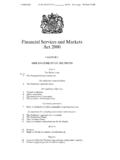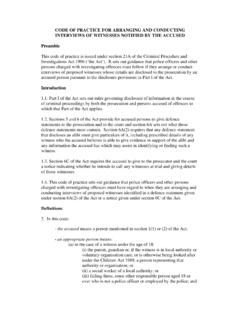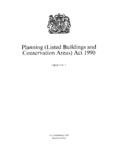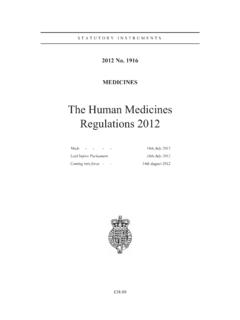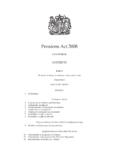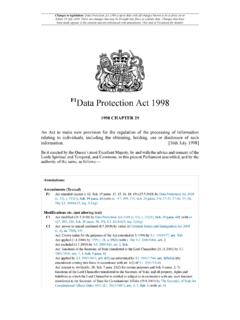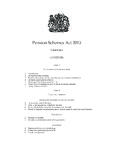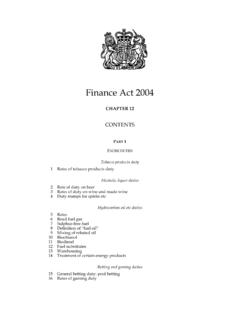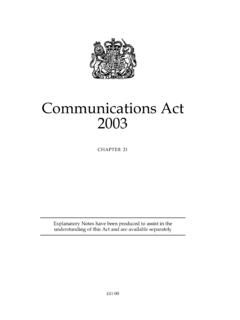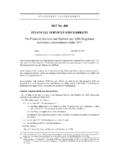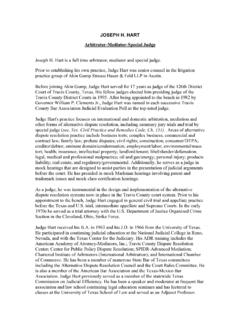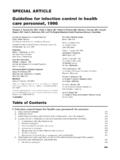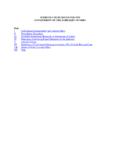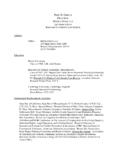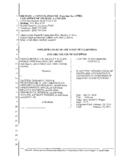Transcription of EXPLANATORY NOTES Deregulation Act 2015 - …
1 EXPLANATORY NOTESD eregulation Act 2015 Chapter 20 These NOTES refer to the Deregulation Act 2015 (c. 20) which received Royal Assent on 26 March 2015 1 Deregulation ACT 2015 EXPLANATORY NOTES INTRODUCTION 1. These EXPLANATORY NOTES relate to the Deregulation Act 2015 which received Royal Assent on 26 March 2015 . They have been prepared by the Cabinet Office in order to assist the reader in understanding the Act. They do not form part of the Act and have not been endorsed by Parliament. 2. The NOTES need to be read in conjunction with the Act. They are not, and are not meant to be, a comprehensive description of the Act. So where a section or Schedule, or part of a section or Schedule, does not seem to require any explanation or comment, none is given. SUMMARY 3. The Deregulation Act provides for the removal or reduction of burdens on businesses, civil society, individuals, public sector bodies and the taxpayer.
2 These include measures relating to general and specific areas of business, companies and insolvency, the use of land, housing and development, transport, communications, the environment, the regulation of child trust funds, education and training, alcohol, sport and entertainment, the administration of justice, public authorities and legislative reform. The Act also provides for a duty on those exercising specified regulatory functions to have regard to the desirability of promoting economic growth. In addition, the Act repeals legislation that is no longer of practical use. BACKGROUND 4. The government published a draft Deregulation Bill on 1 July 2013. The draft Bill was subject to pre-legislative scrutiny by a Joint Committee. That Committee published its report on 19 December 2013. In response to the Joint Committee s report, the government introduced the Bill in a revised form.
3 The government s response to the Joint Committee, which provides detailed responses to the Committee s recommendations, was published in January 2014. The Bill had its First Reading in the House of Commons on 23 January 2014 and was carried over to the next Parliamentary Session under Standing Order It was introduced in the House of Lords on 24 June 2014. The carry-over motion was subsequently extended. The Table at the end of the NOTES gives details of the parliamentary proceedings. These NOTES refer to the Deregulation Act 2015 (c. 20) which received Royal Assent on 26 March 2015 2 5. The Bill was presented by the government as contributing to its commitment to reduce or improve regulation and to cut "red tape" during the 2010 to 2015 Parliament. As such, several of the measures in the Bill were brought forward from the government s "Red Tape Challenge" programme which sought views from businesses and the public on the removal and reform of areas of regulation.
4 TERRITORIAL EXTENT AND APPLICATION 6. section 114 sets out the territorial extent of the Act. The Act makes a large number of repeals, revocations and other amendments of legislation. section 114(1) provides that, except where specified, any repeal, revocation or other amendment or modification made by the Act has the same extent as the original legislation. The commentary on the various provisions explains their extent and also their application (if different from their extent). 7. section 114(2) and (3) set out exceptions to the general principle in section 114(1). 8. section 114(2) provides that the following provisions form part of the law of England and Wales and Northern Ireland: paragraphs 4 (repeal of the Mining Industry Act 1920), 31(b) and (c) (repeal of the Fisheries Act 1891 and the British Fishing Boats Act 1983), and 39 (repeal of Milk (Cessation of Production) Act 1985) of Schedule 23; as a consequence of the extent of paragraphs 31(b) and (c), paragraphs 32(2), 32(3) so far as relating to paragraphs 9 and 68 of Schedule 13 to the Merchant Shipping Act 1995, 32(4) and (5) of Schedule 23.
5 9. section 114(3) provides that the following provisions form part of the law of England and Wales only: section 15 (suppliers of fuels and fireplaces), and Parts 4 and 5 of Schedule 13 (Air Quality and Noise Abatement Zones); paragraphs 5 (an amendment consequential on the repeal of the Mining Industry Act 1920), 35 and 36 (repeal of Breeding of Dogs Act 1973 and consequential amendments), 41 (repeal of Breeding and Sale of Dogs (Welfare) Act 1999), 42 (revocation of Coal and Other Mines (Horses) Order 1956) and 45 (repeal of various provisions of the Town Police Clauses Act 1847) of Schedule 23. 10. section 114(4) to (6) set out the extent of those provisions of the Act which do not amend other legislation. These NOTES refer to the Deregulation Act 2015 (c. 20) which received Royal Assent on 26 March 2015 3 11. section 114(4) provides that the following provisions form part of the law of England and Wales only: sections 4 (English Apprenticeships: funding arrangements) and 5 (English apprenticeships: disclosure of information); section 26(7) to (10) (public rights of way: procedure provisions); sections 33, 34 and 41 (which relate to preventing retaliatory eviction); section 45 (Short-term use of London accommodation: power to relax restrictions); section 64(1) and (2) (Abolition of Office of Chief Executive of Skills Funding), (With very limited exceptions, the Chief Executive s current functions are exercisable in relation only to England); and section 75(6) to (9) (Motor racing: consequential provisions).
6 12. section 114(5) provides that section 75(10) to (13) (Motor racing: consequential provisions) forms part of the law of Scotland only. 13. section 114(6) provides that the following provisions form part of the law of England and Wales, Scotland and Northern Ireland: sections 77 and 78 (which relate to TV licensing); section 85 (power of HMRC to disclose information for purposes of certain litigation); the new power, conferred by section 104, to enable a Minister to amend commencement dates in legislation, so that reference is made to the date on which a provision actually came into force, or an event actually occurred; the new power, conferred by section 105, to enable different forms of subordinate legislation to be combined; the provisions set out in sections 108 to 111 (provisions concerning the promotion of economic growth); the provisions concerning consequential changes, financial provision, commencement and short title set out in sections 112, 113, 115 and 116.
7 14. section 114(7) provides a power, exercisable by Her Majesty by Order in Council, to provide for any of the provisions of section 78 to extend, with or without modifications, to any of the Channel Islands or the Isle of Man. These NOTES refer to the Deregulation Act 2015 (c. 20) which received Royal Assent on 26 March 2015 4 COMMENTARY ON SECTIONS section 1: Health and safety at work: general duty of self-employed persons 15. This section makes amendments to section 3 of the Health and Safety at Work etc. Act 1974 (general duty of employers and self-employed to persons other than their employees). 16. Subsection (2) amends section 3(2) of the Health and Safety at Work etc. Act 1974 (which imposes a general duty with respect to health and safety on all self-employed persons). The purpose of this amendment is to limit the scope of the general duty under section 3(2) so that only self-employed persons who conduct an undertaking of a prescribed description have an obligation to conduct their undertaking in such a way as to ensure that, so far as is reasonably practicable, they themselves and other persons who may be affected thereby are not exposed to risks to their health and safety.
8 Prescribed has a specific meaning within Part 1 of the Health and Safety at Work etc. Act 1974. It is defined by section 53(1) to mean prescribed by regulations made by the Secretary of State . Subsection (2) therefore enables the Secretary of State to make regulations for the purposes of bringing self-employed persons within the scope of section 3(2). The regulations will be subject to affirmative procedure (subsection (5)). 17. Subsection (3) inserts a new subsection (2A) into section 3. The new subsection sets out the ways in which undertakings may be described in regulations made under section 3(2) (as amended). Paragraph (a) covers descriptions based on the type of activities carried out by the undertaking or on other features of the undertaking, such as its involvement with a specific hazard. Paragraph (b) ensures that the regulations could include a general description covering any undertaking the conduct of which may expose others to risks to their health or safety.
9 18. The section is a deregulatory provision because it will exempt from section 3(2) of the Health and Safety at Work etc. Act 1974 those self-employed persons who do not conduct a prescribed undertaking. 19. section 11(4)(b)(i) of the Health and Safety at Work etc. Act 1974 (functions of the Executive) prevents the Health and Safety Executive from submitting proposals to the Secretary of State for the making of regulations for railway safety purposes. Subsection (4) of this section removes the new regulation-making power in section 3(2) of the Health and Safety at Work etc. Act 1974 (as amended) from the scope of section 11(4)(b)(i). This will enable the Health and Safety Executive to recommend proposals to the Secretary of State for the making of regulations that prescribe undertakings for railway safety purposes. 20. section 84(3) of the Health and Safety at Work etc.
10 Act 1974 includes a power for Her Majesty by Order in Council to apply provisions of the Act outside Great Britain. In the event that such an Order in Council is in force when the section comes into force, subsection (6) of this section provides for the amendments made to sections 3 and 11 of the Health and Safety at Work etc. Act 1974 to apply outside Great Britain for such purposes as may be specified in the Order. These NOTES refer to the Deregulation Act 2015 (c. 20) which received Royal Assent on 26 March 2015 5 21. This section forms part of the law of England and Wales and Scotland. It comes into force on the day on which the Act is passed so far as necessary for enabling regulations under section 3(2) to be made. It comes into force for remaining purposes on a day to be appointed by the Secretary of State in a commencement order. section 2: Removal of employment tribunals power to make wider recommendations 22.
